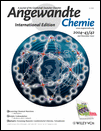Design and Synthesis of Photochemically Controllable Caspase-3†
Masayuki Endo Dr.
Institute of Scientific and Industrial Research, Osaka University, 8-1 Mihogaoka, Ibaraki, Osaka 567–0047, Japan, Fax: (+81) 6-6879-8499
Search for more papers by this authorKoji Nakayama
Institute of Scientific and Industrial Research, Osaka University, 8-1 Mihogaoka, Ibaraki, Osaka 567–0047, Japan, Fax: (+81) 6-6879-8499
Search for more papers by this authorYuka Kaida
Institute of Scientific and Industrial Research, Osaka University, 8-1 Mihogaoka, Ibaraki, Osaka 567–0047, Japan, Fax: (+81) 6-6879-8499
Search for more papers by this authorTetsuro Majima Dr.
Institute of Scientific and Industrial Research, Osaka University, 8-1 Mihogaoka, Ibaraki, Osaka 567–0047, Japan, Fax: (+81) 6-6879-8499
Search for more papers by this authorMasayuki Endo Dr.
Institute of Scientific and Industrial Research, Osaka University, 8-1 Mihogaoka, Ibaraki, Osaka 567–0047, Japan, Fax: (+81) 6-6879-8499
Search for more papers by this authorKoji Nakayama
Institute of Scientific and Industrial Research, Osaka University, 8-1 Mihogaoka, Ibaraki, Osaka 567–0047, Japan, Fax: (+81) 6-6879-8499
Search for more papers by this authorYuka Kaida
Institute of Scientific and Industrial Research, Osaka University, 8-1 Mihogaoka, Ibaraki, Osaka 567–0047, Japan, Fax: (+81) 6-6879-8499
Search for more papers by this authorTetsuro Majima Dr.
Institute of Scientific and Industrial Research, Osaka University, 8-1 Mihogaoka, Ibaraki, Osaka 567–0047, Japan, Fax: (+81) 6-6879-8499
Search for more papers by this authorWe thank Dr. Yoshihide Tsujimoto (Osaka University Medical School) for providing cDNA of human caspase-3. This work was supported by a Grant-in-Aid for Scientific Research on Priority Area (417), 21st Century COE Research, and from the Ministry of Education, Culture, Sports, Science, and Technology (MEXT) of the Japanese Government.
Graphical Abstract
The selective cleavage achieved by activated caspase-8 has been mimicked by using a photofunctionalized caspase-3 having 2-nitrophenylglycine (Npg) at a specific position of the peptide chain (see picture). The study shows that the activity of caspase-3 has been clearly expressed by photoirradiation and that autocleavage of caspase-3 has been suppressed by the site-selective incorporation of the Npg residue.
Supporting Information
Supporting information for this article is available on the WWW under http://www.wiley-vch.de/contents/jc_2002/2004/z460889_s.pdf or from the author.
Please note: The publisher is not responsible for the content or functionality of any supporting information supplied by the authors. Any queries (other than missing content) should be directed to the corresponding author for the article.
References
- 1
- 1aM. Raff, Nature 1998, 396, 119–122;
- 1bK. C. Zimmermann, C. Bonzon, D. R. Green, Pharm. Ther. 2001, 92, 57–70.
- 2
- 2aG. S. Salvesen, V. M. Dixit, Cell 1997, 91, 443–446;
- 2bX. Yang, H. Y. Chang, D. Baltimore, Mol. Cell 1998, 1, 319–325;
- 2dW. C. Earnshaw, L. M. Martins, S. H. Kaufmann, Anuu. Rev. Biochem. 1999, 68, 383–424;
- 2cY. Shi, Mol. Cell 2002, 9, 459–470.
- 3
- 3aG. Marriott, Biochemistry 1994, 33, 9092–9097;
- 3bS. Thompson, J. A. Spoors, M.-C. Fawcett, C. H. Self, Biochem. Biophys. Res. Commun. 1994, 201, 1213–1219;
- 3cR. Folan, U. Zehavi, M. Naim, A. Patchornik, P. Smirnoff, Biochim. Biophys. Res. Commun. 1994, 201, 1213–1219;
- 3dC.-Y. Chang, B. Niblack, B. Walker, H. Bayley, Chem. Biol. 1995, 2, 391–400;
- 3eG. Marriott, M. Heidecker, Biochemistry 1996, 35, 3170–3174;
- 3fC. H. Self, S. Thompson, Nat. Med. 1996, 2, 817–820.
- 4 J. Rotonda, D. W. Nicholson, K. M. Fazil, M. Gallant, Y. Gareau, M. Labelle, E. P. Peterson, D. M. Rasper, R. Ruel, J. P. Vaillancourt, N. A. Thornberry, J. W. Becker, Nat. Struct. Biol. 1996, 3, 619–625.
- 5
- 5aT. Milburn, N. Matsubara, A. P. Billington, J. B. Udgaonkar, J. W. Walker, B. K. Carpenter, W. W. Webb, J. Marque, W. Denk, J. A. McCray, G. P. Hess, Biochemistry 1989, 28, 49–55;
- 5bD. Ramesh, R. Wieboldt, A. P. Billington, B. K. Carpenter, G. P. Hess, J. Org. Chem. 1993, 58, 4599–4605;
- 5cR. Wieboldt, D. Ramesh, B. K. Carpenter, G. P. Hess, Biochemistry 1994, 33, 1526–1533.
- 6
- 6aP. M. England, H. A. Lester, N. Davidson, D. A. Dougherty, Proc. Natl. Acad. Sci. USA 1997, 94, 11 025–11 030;
- 6bM. W. Nowak, J. P. Gallivan, S. K. Silverman, C. G. Labarca, D. A. Dougherty, H. A. Lester, Methods Enzymol. 1998, 293, 504–529.
- 7For examples of site-selectively photofunctionalized proteins using in vitro translation, see
- 7aS. N. Cook, W. E. Jack, X. Xiong, L. E. Danley, J. A. Ellman, P. G. Schultz, C. J. Noren, Angew. Chem. 1995, 107, 1736–1737;
10.1002/ange.19951071516 Google ScholarAngew. Chem. Int. Ed. Engl. 1995, 34, 1629–1630;
- 7bM. W. Nowak, P. C. Kearney, J. R. Sampson, M. E. Saks, C. G. Labarca, S. K. Silverman, W. Zhong, J. Thorson, J. N. Abelson, N. Davidson, P. G. Schultz, D. A. Dougherty, H. A. Lester, Science 1995, 268, 439–442;
- 7cS. K. Pollitt, P. G. Schultz, Angew. Chem. 1998, 110, 2252–2255;
10.1002/(SICI)1521-3757(19980803)110:15<2252::AID-ANGE2252>3.0.CO;2-I Google ScholarAngew. Chem. Int. Ed. Engl. 1998, 37, 2104–2107;10.1002/(SICI)1521-3773(19980817)37:15<2104::AID-ANIE2104>3.0.CO;2-Z CAS Web of Science® Google Scholar
- 7dG. F. Short III, M. Lodder, A. L. Laikhter, T. Arslan, S. M. Hecht, J. Am. Chem. Soc. 1999, 121, 478–479;
- 7eM. Endo, K. Nakayama, T. Majima, J. Org. Chem. 2004, 69, 4292–4298.
- 8
- 8aT. Hohsaka, Y. Ashizuka, H. Murakami, M. Sisido, J. Am. Chem. Soc. 1996, 118, 9778–9779;
- 8bT. Hohsaka, D. Kajihara, Y. Ashizuka, H. Murakami, M. Sisido, J. Am. Chem. Soc. 1999, 121, 34–40;
- 8cT. Hohsaka, Y. Ashizuka, H. Taira, H. Murakami, M. Sisido, Biochemistry 2001, 40, 11 060–11 064.
- 9
- 9aA. M. Vocero-Akbani, N. V. Heyden, N. A. Lissy, L. Ratner, S. F. Dowdy, Nat. Med. 1999, 5, 29–33;
- 9bS. R. Schwarze, A. Ho, A. Vocero-Akbani, S. F. Dowdy, Science 1999, 285, 1569–1572;
- 9cS. R. Schwarze, K. A. Hruska, S. F. Dowdy, Trends Cell Biol. 2000, 10, 290–295.





